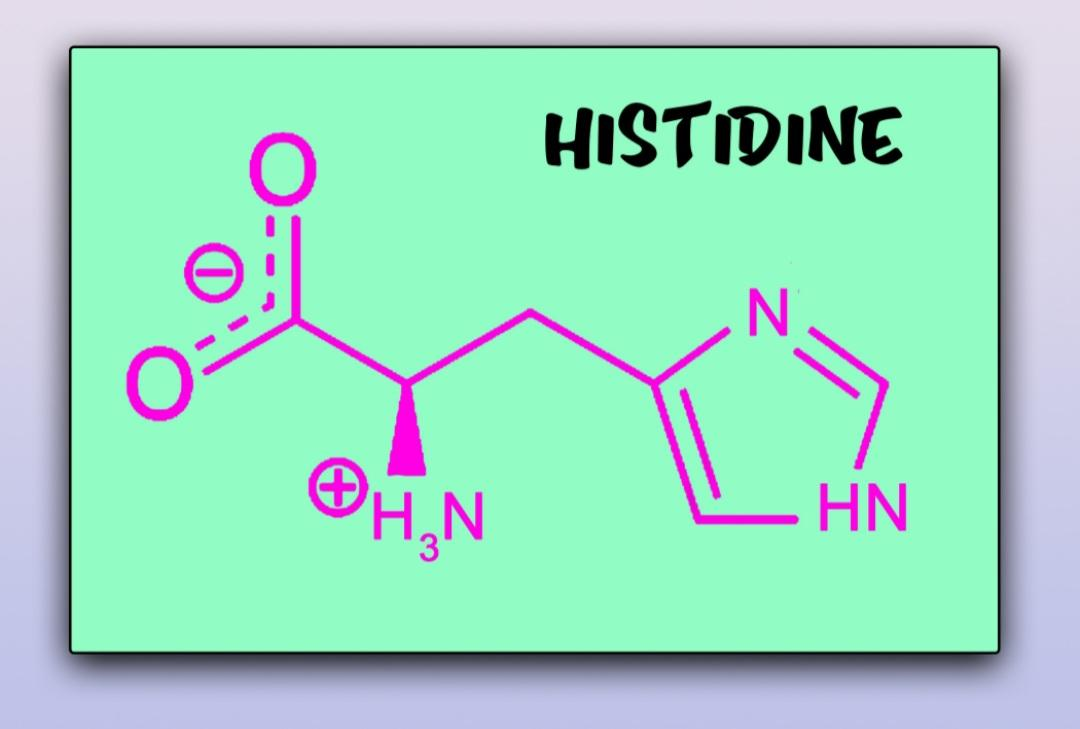
The most basic amino acid is
(A) Arginine
(B) Histidine
(C) Glycine
(D) Glutamine
Answer
558k+ views
Hint: The most basic amino acid is an α-amino acid that is used in the biosynthesis of proteins. It contains an α-amino group, along with it a carboxylic acid group, and an imidazole side chain, classifying it as a positively charged amino acid at physiological pH.
Complete answer:
The most basic amino acid is Histidine. Glutamine and glycine aren't basic amino acids.

Only Arginine and Histidine are basic amino acids even out of these two, histidine is weakly charged under physiological ph.
Additional Information: Histidine is one of that type of amino acids that can be converted to intermediates of the tricarboxylic acid (TCA) cycle. Histidine, along with some other amino acids such as proline and arginine, will take part in deamination, which is a process in which its amino group is removed. In the prokaryotes, it was seen that histidine is first converted to urocanate by histidase. Then, urocanase converts urocanate to 4-imidazolone-5-propionate. The Imidazolonepropionase is an enzyme that will help in catalyzing the reaction to form formiminoglutamate from the 4-imidazolone-5-propionate. The formimino group is transferred to tetrahydrofolate, and the remaining five carbons form the product which is commonly known as glutamate. These reactions will result in the formation of glutamate and ammonia. The glutamate can then be deaminated by glutamate dehydrogenase or transaminated to form α-ketoglutarate.l-Histidine, is an important amino acid that's not synthesized de novo in humans. Humans and other animals must ingest histidine or histidine-containing proteins. The biosynthesis of the histidine has been majorly studied in prokaryotes like E. coli.
So, the correct answer is ‘(B) Histidine’.
Note: Histidine was first isolated by the German physician Albrecht Kossel and Sven Gustaf Hedin in 1896. It's also a precursor to histamine, an important inflammatory agent in immune responses. The acyl radical is histidyl.
Complete answer:
The most basic amino acid is Histidine. Glutamine and glycine aren't basic amino acids.

Only Arginine and Histidine are basic amino acids even out of these two, histidine is weakly charged under physiological ph.
Additional Information: Histidine is one of that type of amino acids that can be converted to intermediates of the tricarboxylic acid (TCA) cycle. Histidine, along with some other amino acids such as proline and arginine, will take part in deamination, which is a process in which its amino group is removed. In the prokaryotes, it was seen that histidine is first converted to urocanate by histidase. Then, urocanase converts urocanate to 4-imidazolone-5-propionate. The Imidazolonepropionase is an enzyme that will help in catalyzing the reaction to form formiminoglutamate from the 4-imidazolone-5-propionate. The formimino group is transferred to tetrahydrofolate, and the remaining five carbons form the product which is commonly known as glutamate. These reactions will result in the formation of glutamate and ammonia. The glutamate can then be deaminated by glutamate dehydrogenase or transaminated to form α-ketoglutarate.l-Histidine, is an important amino acid that's not synthesized de novo in humans. Humans and other animals must ingest histidine or histidine-containing proteins. The biosynthesis of the histidine has been majorly studied in prokaryotes like E. coli.
So, the correct answer is ‘(B) Histidine’.
Note: Histidine was first isolated by the German physician Albrecht Kossel and Sven Gustaf Hedin in 1896. It's also a precursor to histamine, an important inflammatory agent in immune responses. The acyl radical is histidyl.
Recently Updated Pages
The number of solutions in x in 02pi for which sqrt class 12 maths CBSE

Write any two methods of preparation of phenol Give class 12 chemistry CBSE

Differentiate between action potential and resting class 12 biology CBSE

Two plane mirrors arranged at right angles to each class 12 physics CBSE

Which of the following molecules is are chiral A I class 12 chemistry CBSE

Name different types of neurons and give one function class 12 biology CBSE

Trending doubts
One Metric ton is equal to kg A 10000 B 1000 C 100 class 11 physics CBSE

Explain zero factorial class 11 maths CBSE

What is 1s 2s 2p 3s 3p class 11 chemistry CBSE

Discuss the various forms of bacteria class 11 biology CBSE

State the laws of reflection of light

An example of chemosynthetic bacteria is A E coli B class 11 biology CBSE




